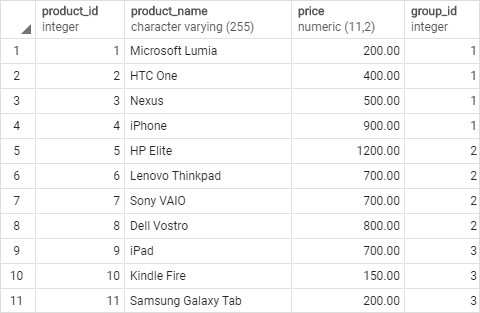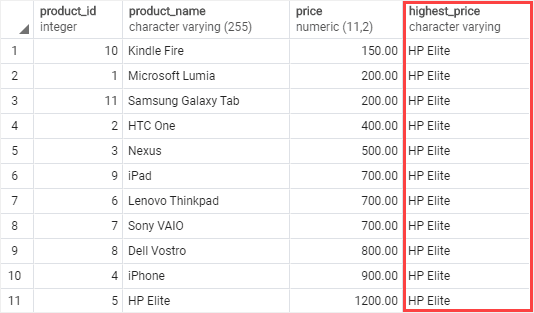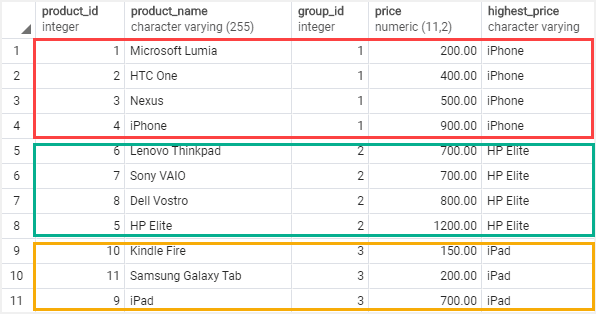PostgreSQL LAST_VALUE Function
Summary: in this tutorial, you will learn how to get the last value in an ordered partition of a result set by using the PostgreSQL LAST_VALUE() function.
Introduction to PostgreSQL LAST_VALUE() function
The LAST_VALUE() function returns the last value in an ordered partition of a result set.
The syntax of the LAST_VALUE() function is as follows:
LAST_VALUE ( expression )
OVER (
[PARTITION BY partition_expression, ... ]
ORDER BY sort_expression [ASC | DESC], ...
)In this syntax:
expression
The expression can be an expression, column, or subquery evaluated against the value of the last row in an ordered partition of the result set.
The expression must return a single value. Additionally, it cannot be a window function.
PARTITION BY clause
The PARTITION BY clause divides rows of the result set into partitions to which the LAST_VALUE() function is applied.
If you omit the PARTITION BY clause, the LAST_VALUE() function will treat the whole result set as a single partition.
ORDER BY clause
The ORDER BY clause specifies the sort order for rows in each partition to which the LAST_VALUE() function is applied.
frame_clause
The frame_clause defines the subset of rows in the current partition to which the LAST_VALUE() function is applied.
PostgreSQL LAST_VALUE() function examples
We will use the products table created in the window function tutorial for the demonstration:
 Here are the contents of the data of the
Here are the contents of the data of the products table:

1) Using PostgreSQL LAST_VALUE() over a result set example
The following example uses the LAST_VALUE() function to return all products together with the product that has the highest price:
SELECT
product_id,
product_name,
price,
LAST_VALUE(product_name)
OVER(
ORDER BY price
RANGE BETWEEN
UNBOUNDED PRECEDING AND
UNBOUNDED FOLLOWING
) highest_price
FROM
products; In this example:
In this example:
- Since we omit the
PARTITION BYclause in theLAST_VALUE()function, the function treats the whole result set as a single partition. - The
ORDER BYclause sorts products by prices from low to high. - The
LAST_VALUE()retrieves the product name of the last row in the result set.
2) Using PostgreSQL LAST_VALUE() over a partition example
The following example uses the LAST_VALUE() function to return all products together with the most expensive product per product group:
SELECT
product_id,
product_name,
group_id,
price,
LAST_VALUE(product_name)
OVER(
PARTITION BY group_id
ORDER BY price
RANGE BETWEEN
UNBOUNDED PRECEDING AND
UNBOUNDED FOLLOWING
) highest_price
FROM
products; In this example:
In this example:
- The
PARTITION BYclause divides rows by group id into three partitions specified by group id 1, 2, and 3. - The
ORDER BYclause sorts products in each product group ( or partition) from low to high. - The
RANGE BETWEEN UNBOUNDED PRECEDING AND UNBOUNDED FOLLOWINGclause defines the frame starting from the first row and ending at the last row of each partition. - The
LAST_VALUE()function applies to each partition separately and returns the product name of the last row in each partition.
Summary
- Use the PostgreSQL
LAST_VALUE()window function to return the last value in an ordered partition of a result set.